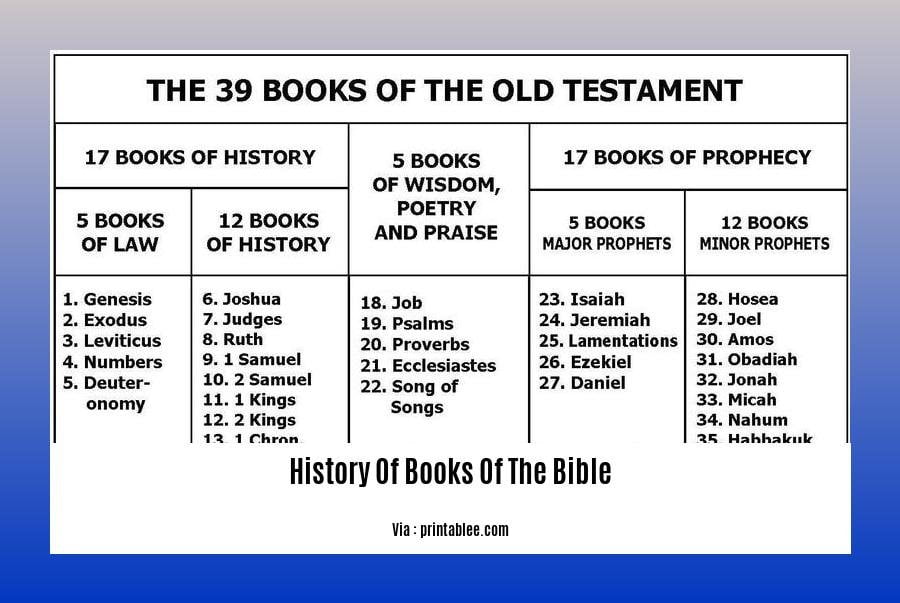[A Scholarly Examination of the History of Books of the Bible] Delve into the captivating history of the books that constitute the Bible. This scholarly exploration unveils the origins, authorship, and evolution of these sacred texts, shedding light on the historical tapestry woven into the written word. Through meticulous research and analysis of ancient manuscripts and archaeological evidence, we embark on a journey to decipher the fascinating story behind the Bible’s genesis.
Key Takeaways:
- Dating of Historical Books:
- Nehemiah: 445-420 B.C.
- 2 Chronicles: 450-425 B.C.
- Joshua: 1400-1370 B.C.
- Ezra: 460-440 B.C.
- Esther: 460-350 B.C.
- Significance of Historical Books:
- Reveal God’s faithfulness, mercy, and discipline.
- Prophesied the coming of the Messiah from King David’s lineage.
History Of Books Of The Bible

The Bible is a captivating anthology of ancient writings revered by billions worldwide. Its historical books, in particular, provide a chronological account of Israel’s tumultuous journey, recording the triumphs and trials of a chosen people.
The History Of Books Of The Bible encompasses a diverse collection of genres, including historical narratives, genealogies, legal codes, and prophetic oracles. These books offer invaluable insights into the cultural, religious, and political landscape of the ancient Near East.
Unveiling the Bible’s Historical tapestry
Penned by various authors over centuries, the historical books of the Bible reflect the evolving perspectives and experiences of Israel’s people. From Moses’ leadership during the Exodus to the exile in Babylon and the restoration of Jerusalem, these writings chronicle the nation’s triumphs and tribulations.
The books of Joshua, Judges, and Samuel narrate the conquest of the Promised Land and the establishment of a monarchy. Kings and Chronicles provide a comprehensive account of the united and divided kingdoms of Israel and Judah, highlighting the rise and fall of kings and the spiritual challenges they faced.
Ezra and Nehemiah document the return of the exiled Israelites to Jerusalem and the rebuilding of the Temple. Esther recounts the heroism of a young Jewish woman who saved her people from annihilation. Ruth tells a timeless tale of love, loyalty, and redemption.
Significance of the Historical Books
The historical books of the Bible serve a profound purpose, revealing God’s faithfulness, mercy, and discipline in the lives of individuals and nations. They provide a glimpse into the complexities of human nature, the consequences of sin, and the hope of redemption.
The History Of Books Of The Bible not only enhances our understanding of ancient Israel but also offers timeless lessons for our own lives. They remind us of the importance of faith, obedience, and perseverance in the face of adversity.
Exploring the Historical Books
Delving into the History Of Books Of The Bible is a rewarding endeavor that allows us to appreciate the rich tapestry of Israel’s past. These books offer a unique window into one of the most influential and enduring religious traditions in human history.
For an in-depth exploration of the written word, delve into the history of books, uncovering its fascinating origins, technological advancements, and societal impact throughout the ages. Explore the History Of Books Timeline, a captivating journey through the evolution of books from ancient scrolls to modern-day digital formats. Discover the History Of Books And Reading, shedding light on the profound connection between books and the development of human civilization. Dive into the History Of Books, tracing its remarkable transformation from a sacred object to a ubiquitous source of knowledge and entertainment. Delve into the History Of Books Being Banned, exposing the chilling attempts to silence voices and suppress ideas through censorship. Uncover the History Of Books Read On Kindle, tracing the revolutionary impact of e-readers on the literary landscape. Finally, explore the History Of Bookselling, shedding light on the fascinating world of book distribution, from ancient scribes to modern-day online retailers.
Historical Context of Bible Writing

Moving beyond the text’s literal words, unraveling the Historical Context of Bible Writing is crucial for a deeper understanding. Think of it as a behind-the-scenes look into the world that shaped the biblical narrative.
Uncovering the Historical Tapestry
Imagine yourself as a biblical detective, piecing together fragments of an ancient puzzle. Understanding the historical context involves:
- Identifying the Author: Who wrote the book? Their background and perspective influence the text’s content.
- Contextualizing the Audience: To whom was the book addressed? Their beliefs, values, and experiences shape the message.
- Examining the Historical Setting: When and where was the book written? Events and cultural norms of the time provide context.
The Significance of Historical Context
Why does historical context matter? Because it:
- Illuminates the Message: Knowing the author’s intent and the audience’s perspective clarifies the text’s meaning.
- Enhances Interpretation: It helps interpret passages accurately, avoiding misinterpretations based on modern biases.
- Provides a Deeper Understanding: It enriches our understanding of God’s interaction with humanity throughout history.
Key Takeaways:
- Historical context is vital for deciphering the Historical Context of Bible Writing.
- Uncovering the author, audience, and historical setting provides valuable insights.
- Understanding historical context enhances the interpretation and significance of the biblical message.
Relevant URL Sources:
– Zondervan Academic: How to Read the Bible in Context
– Knowable Word: Three Important Contexts for Bible Study
Evolution of Biblical Texts
The Evolution of Biblical Texts has undergone remarkable transformation from ancient scrolls to modern codices. Originally recorded on fragile papyrus or animal skins, biblical texts were later inscribed on more durable parchments, transitioning from unwieldy scrolls to convenient codex formats. This evolution enhanced portability, durability, and ease of reference, paving the way for the widespread dissemination of the Bible.
Over a vast expanse of time, the Bible has taken shape through the contributions of numerous authors, spanning over 1,500 years from the Old Testament to the New Testament. The Old Testament, completed centuries before the birth of Jesus Christ, chronicles the history of Israel, while the New Testament captures the life and teachings of Jesus and the early Christian church.
Key Takeaways:
- Biblical texts evolved from scrolls to codices for greater portability and convenience.
- The Bible encompasses 66 books written over 1,500 years by diverse authors.
- The Old Testament was completed before Jesus Christ’s birth, while the New Testament was written after his death and resurrection.
Relevant URL Sources:
Archaeological Evidence and the Bible
Digging into the Past to Illuminate the Word
Archaeological discoveries have played a transformative role in understanding the Bible, revealing tangible evidence that illuminates the historical accuracy and context of its narratives. Through the meticulous excavation of ancient sites and the analysis of artifacts, scholars have gained invaluable insights into the world that shaped the biblical stories.
Unveiling the Physical Landscapes
Archaeology has brought to life the physical landscapes described in the Bible. Excavations at Tell el-Hesi, identified as the biblical city of Lachish, unearthed evidence of its destruction in 589/588 BC, corroborating the account in the Book of Jeremiah. The Tel Dan Inscription, discovered in 1993, bears the phrase “House of David,” providing extra-biblical confirmation of the existence of King David in the ninth century BC.
Preserving Ancient Wisdom
The Dead Sea Scrolls, discovered in 1947, are a treasure trove of ancient biblical manuscripts that provide a glimpse into Jewish practices and beliefs during the Second Temple period. They contain portions of every book in the Hebrew Bible except Esther, offering invaluable insights into textual variations and the development of the biblical canon.
Deciphering Ancient Languages
The Rosetta Stone, discovered in 1798, was a key to deciphering Egyptian hieroglyphs. This breakthrough enabled scholars to translate ancient Egyptian texts, providing historical context for the biblical narrative. For example, the Merneptah Stele, dating back to 1209 BC, mentions Israel, offering archaeological evidence for the existence of the Israelites during that period.
Key Takeaways:
- Archaeological Evidence Corroborates Biblical Narratives: Discoveries at Lachish and Tel Dan support historical accounts in the Bible.
- Ancient Manuscripts Provide Insights: The Dead Sea Scrolls offer valuable information about Jewish practices and biblical texts.
- Deciphered Languages Illuminate Context: The Rosetta Stone and other discoveries have shed light on the historical backdrop of the biblical stories.
- Archaeology Enhances Understanding: Archaeological evidence enriches our comprehension of the Bible’s historical context and cultural significance.
Citation:
* Biblical Archaeology Society: Ten Top Biblical Archaeology Discoveries
* Redeemer’s Savior: 8 Archaeological Discoveries That Support The Bible
FAQ
Q1: When were the different historical books of the Bible written?
A1: The dates of writing for the historical books of the Bible vary. For example, Nehemiah was written between 445-420 B.C., while Joshua was written between 1400-1370 B.C.
Q2: Who is considered the author of the book of Ruth?
A1: The author of the book of Ruth is uncertain, as it is not explicitly stated in the text.
Q3: What is the significance of the historical books of the Bible?
A3: The historical books of the Bible reveal God’s faithfulness, mercy, and discipline. They also prophecy the coming of the Messiah from King David’s lineage (2 Samuel 7).
Q4: How does understanding the cultural context help in interpreting the historical books of the Bible?
A4: Exploring the cultural circumstances that shaped the historical books and their features provides a deeper understanding of the text and its significance.
Q5: What are some important archaeological discoveries that support the historical events described in the Bible?
A5: Archaeological discoveries such as the Lachish Ostraca, the Tel Dan Inscription, and the Dead Sea Scrolls provide evidence for the events described in the historical books of the Bible and shed light on the historical context.
- Condoleezza Rice’s Net Worth: Deconstructing the Former Secretary of State’s Fortune - December 19, 2024
- Ace Frehley’s Net Worth in 2024: Exploring the Spaceman’s Fortune - December 19, 2024
- Tim Lanahan: A Life Interrupted - December 19, 2024















